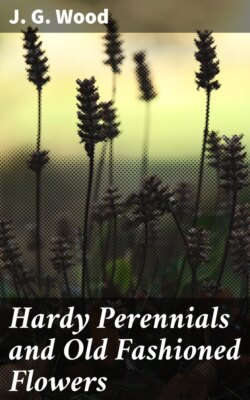Читать книгу Hardy Perennials and Old Fashioned Flowers - J. G. Wood - Страница 37
На сайте Литреса книга снята с продажи.
Arum Crinitum.
ОглавлениеTable of Contents
Hairy Arum, or Dragon's Mouth; Nat. Ord. Araceæ.
As may be seen by the illustration (Fig. 17), this is a most singular plant. It proves hardy in this climate if its position is selected; in other words, it is not hardy in all kinds of soils and situations, but if planted four or five inches deep, in sandy or half decayed vegetable mould, facing the south, there is little to fear either as regards hardiness or its thriving. I think, therefore, it may be called hardy. It is far more interesting than handsome, but there is at the present time an evident desire amongst amateurs to grow the various Arums, and more especially has this one been sought after; I have, therefore, introduced it amongst more beautiful flowers, and given an enlarged drawing of the entire plant, together with the spathe in its unopened state.
The plant is a native of Minorca, and was imported in 1777. In this climate it grows to the height of 18in., developing the flower with the foliage. It is produced on a stout scape nearly 1ft. high, of a pale green colour, marked with dark short lines and spotted with delicate pink dots. The folded spathe is of leather-like substance, rough, almost corky in texture; also variously marked and tinted. At the base there are a number of green lines arranged evenly and longitudinally on a nearly white ground. A little higher—the belly part—the lines are less frequent, irregular, and mixed with pink dots. Still higher, the ground colour becomes pale green, the lines dark green, and the pink spots are changed to clouded tints; the remainder of the folded spathe—to the tip—is a mixture of brown and green dots, the total length being fully 9in. When the spathe opens, it does so quickly, bending more than half its length outwards, the division looking upwards. To those who have not before seen the plant at this stage, it will prove an interesting surprise; the odour, however, is repulsive. The spathe at its widest part is 6in. broad, and tapers off to a blunt point. It is of a dark purple colour and covered with long bent dark hairs, whence the specific name. They are curiously disposed, and remind one of some hairy animal that has been lifted out of the water the wrong way as regards the direction of the hair. The spadix is comparatively small, black, and also covered with hairs. The flower should be closely watched if its peculiarities are to be fully noted, as it not only opens quickly but soon begins to wither. During the short period that the flower is open the lower part of the spathe or belly becomes filled with all kinds of flies, being held by the spear-like hairs.
Fig. 17. Arum Crinitum. (One-fourth natural size.)
The leaves have long stalks, marked and tinted in a similar manner to that of the scape. They are curiously formed and twisted, pedate or bird-foot shaped, the outer segments twice cut, lance-shaped, and turned inwards or over the main part of the leaf; the leaves are of a deep green colour, and of good substance; they seldom exceed four in number to each plant or tuber.
This curious species should, as above indicated, have a warm situation, where it will also be comparatively dry in winter. Its propagation may be effected by division of the roots of strong specimens.
Flowering period, June and July.
